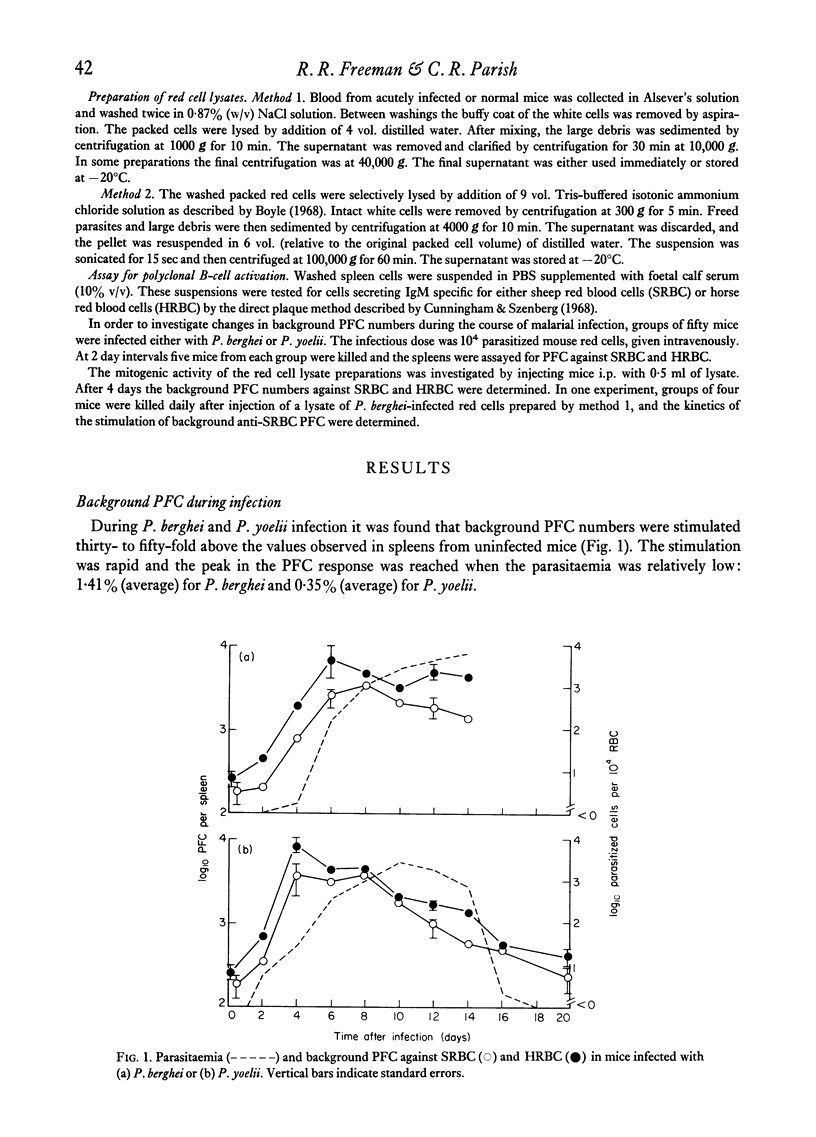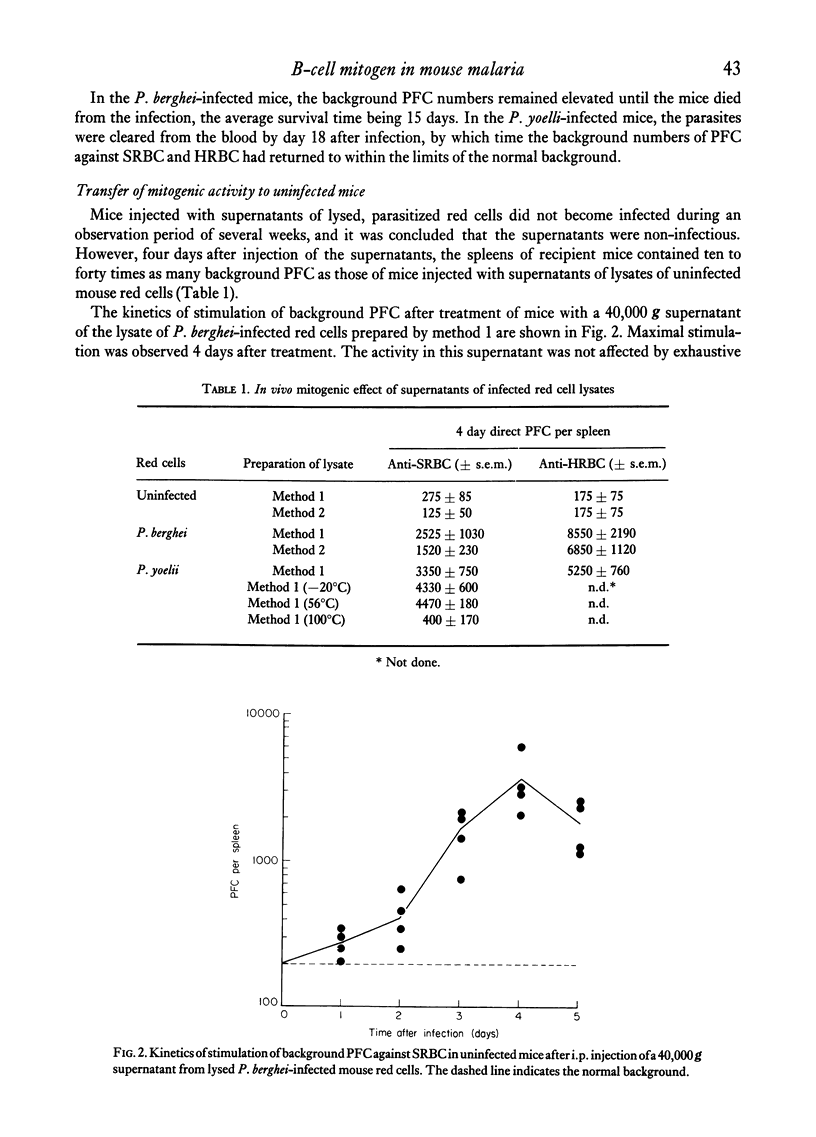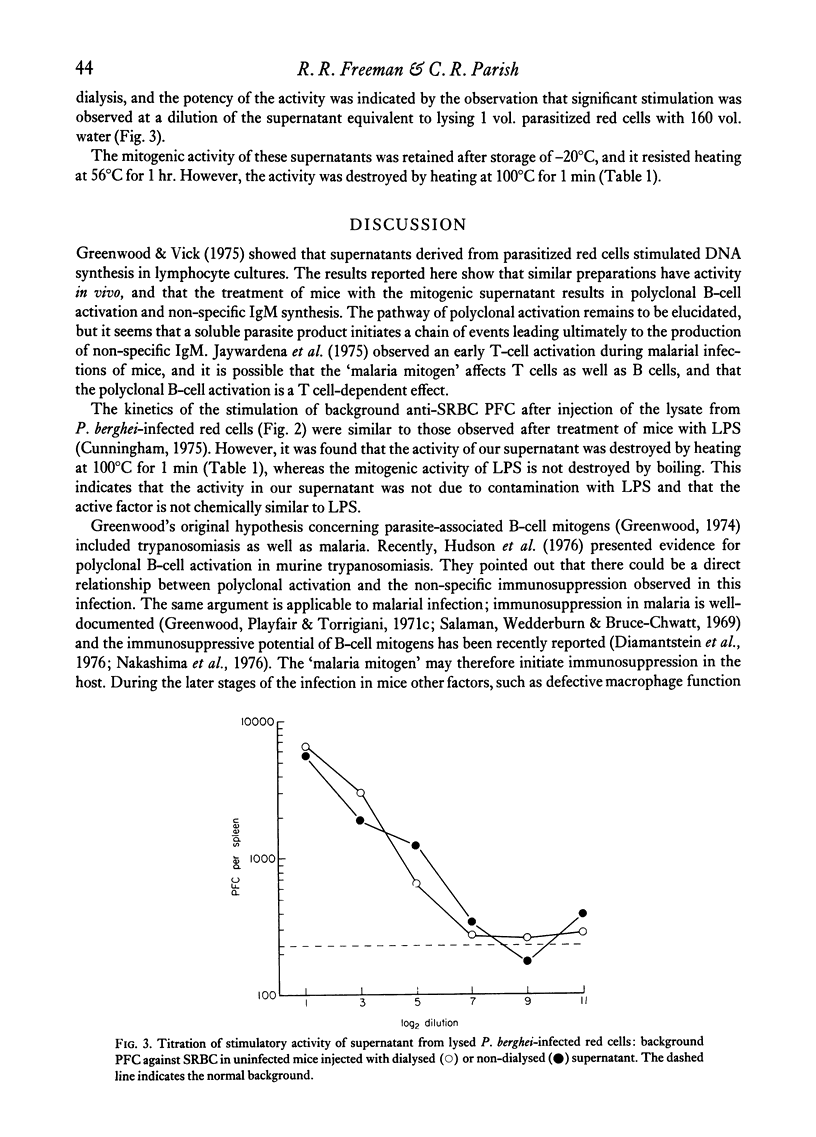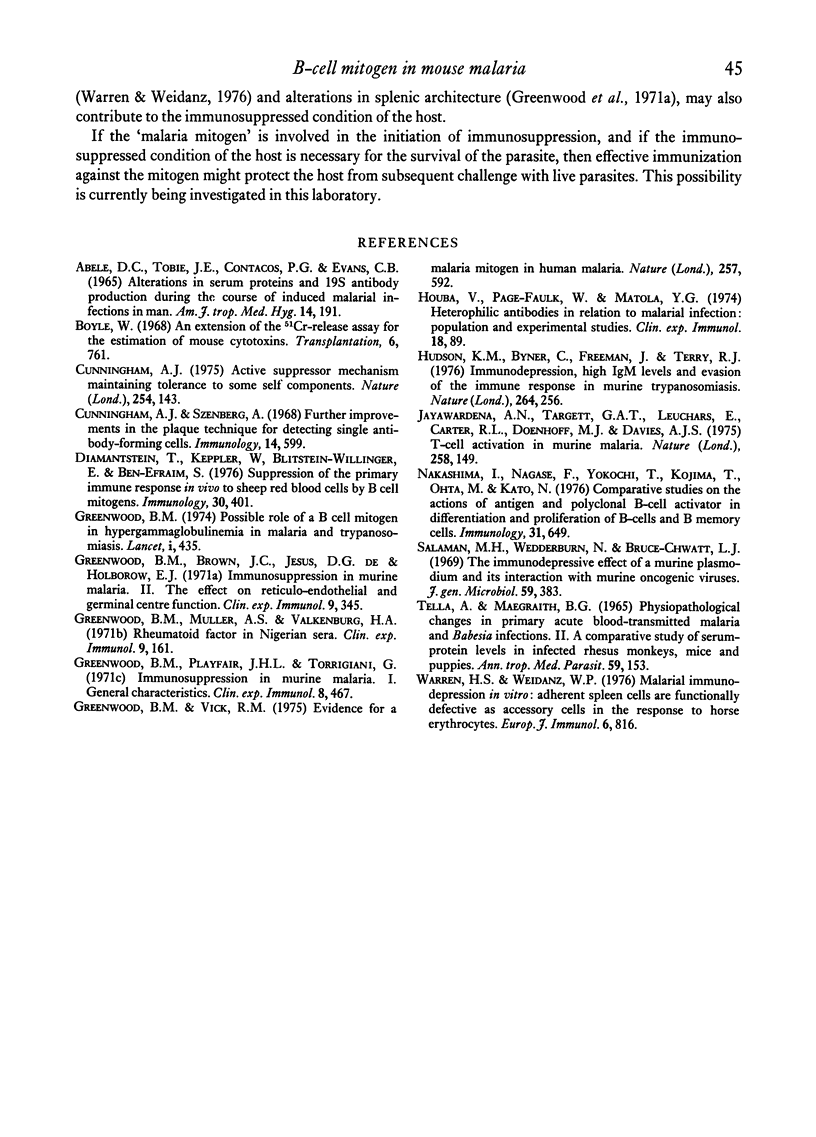Abstract
The numbers of 'background' plaque-forming cells (PFC) secreting IgM specific for either sheep erythrocytes or horse erythrocytes were found to be elevated in the spleens of BALB/c mice during Plasmodium berghei and P. yoelii infection. 'Background' PFC numbers were similarly elevated in the spleens of uninfected mice injected with high speed supernatants of lysates of parasitized red blood cells. The active factor (or factors) in the supernatants was (were) non-dialysable and stable at 56 degrees C, but was (were) destroyed by heating to 100 degrees C.
Full text
PDF




Selected References
These references are in PubMed. This may not be the complete list of references from this article.
- ABELE D. C., TOBIE J. E., HILL G. J., CONTACOS P. G., EVANS C. B. ALTERATIONS IN SERUM PROTEINS AND 19S ANTIBODY PRODUCTION DURING THE COURSE OF INDUCED MALARIAL INFECTIONS IN MAN. Am J Trop Med Hyg. 1965 Mar;14:191–197. doi: 10.4269/ajtmh.1965.14.191. [DOI] [PubMed] [Google Scholar]
- Boyle W. An extension of the 51Cr-release assay for the estimation of mouse cytotoxins. Transplantation. 1968 Sep;6(6):761–764. doi: 10.1097/00007890-196809000-00002. [DOI] [PubMed] [Google Scholar]
- Cunningham A. J. Active suppressor mechanism maintaining tolerance to some self components. Nature. 1975 Mar 13;254(5496):143–144. doi: 10.1038/254143a0. [DOI] [PubMed] [Google Scholar]
- Cunningham A. J., Szenberg A. Further improvements in the plaque technique for detecting single antibody-forming cells. Immunology. 1968 Apr;14(4):599–600. [PMC free article] [PubMed] [Google Scholar]
- Diamantstein T., Keppler W., Blitstein-Willinger E. Suppression of the primary immune response in vivo to sheep red blood cells by B-cell mitogens. Immunology. 1976 Mar;30(3):401–407. [PMC free article] [PubMed] [Google Scholar]
- Greenwood B. M., Brown J. C., De Jesus D. G., Holborow E. J. Immunosuppression in murine malaria. II. The effect on reticulo-endothelial and germinal centre function. Clin Exp Immunol. 1971 Sep;9(3):345–354. [PMC free article] [PubMed] [Google Scholar]
- Greenwood B. M., Muller A. S., Valkenburg H. A. Rheumatoid factor in Nigerian sera. Clin Exp Immunol. 1971 Aug;9(2):161–173. [PMC free article] [PubMed] [Google Scholar]
- Greenwood B. M., Playfair J. H., Torrigiani G. Immunosuppression in murine malaria. I. General characteristics. Clin Exp Immunol. 1971 Mar;8(3):467–478. [PMC free article] [PubMed] [Google Scholar]
- Greenwood B. M. Possible role of a B-cell mitogen in hypergammaglobulinaemia in malaria and trypanosomiasis. Lancet. 1974 Mar 16;1(7855):435–436. doi: 10.1016/s0140-6736(74)92386-1. [DOI] [PubMed] [Google Scholar]
- Greenwood B. M., Vick R. M. Evidence for a malaria mitogen in human malaria. Nature. 1975 Oct 16;257(5527):592–594. doi: 10.1038/257592a0. [DOI] [PubMed] [Google Scholar]
- Houba V., Faulk W. P., Matola Y. G. Heterophilic antibodies in relation to malarial infection: population and experimental studies. Clin Exp Immunol. 1974 Sep;18(1):89–93. [PMC free article] [PubMed] [Google Scholar]
- Hudson K. M., Byner C., Freeman J., Terry R. J. Immunodepression, high IgM levels and evasion of the immune response in murine trypanosomiasis. Nature. 1976 Nov 18;264(5583):256–258. doi: 10.1038/264256a0. [DOI] [PubMed] [Google Scholar]
- Jayawardena A. N., Targett G. A., Leuchars E., Carter R. L., Doenhoff M. J., Davies A. J. T-cell activation in murine malaria. Nature. 1975 Nov 13;258(5531):149–151. doi: 10.1038/258149a0. [DOI] [PubMed] [Google Scholar]
- Nakashima I., Nagase F., Yokochi T., Kojima T., Ohta M., Kato N. Comparative studies on the actions of antigen and polyclonal B-cell activator in differentiation and proliferation of B-cells and B memory cells. Immunology. 1976 Oct;31(4):649–658. [PMC free article] [PubMed] [Google Scholar]
- Salaman M. H., Wedderburn N., Bruce-Chwatt L. J. The immunodepressive effect of a murine plasmodium and its interaction with murine oncogenic viruses. J Gen Microbiol. 1969 Dec;59(3):383–391. doi: 10.1099/00221287-59-3-383. [DOI] [PubMed] [Google Scholar]
- TELLA A., MAEGRAITH B. G. PHYSIOPATHOLOGICAL CHANGES IN PRIMARY ACUTE BLOOD-TRANSMITTED MALARIA AND BABESIA INFECTIONS. II. A COMPARATIVE STUDY OF SERUM-PROTEIN LEVELS IN INFECTED RHESUS MONKEYS, MICE AND PUPPIES. Ann Trop Med Parasitol. 1965 Jun;59:153–158. [PubMed] [Google Scholar]
- Warren H. S., Weidanz W. P. Malarial immunodepression in vitro: adherent spleen cells are functionally defective as accessory cells in the response to horse erythrocytes. Eur J Immunol. 1976 Nov;6(11):816–819. doi: 10.1002/eji.1830061112. [DOI] [PubMed] [Google Scholar]


